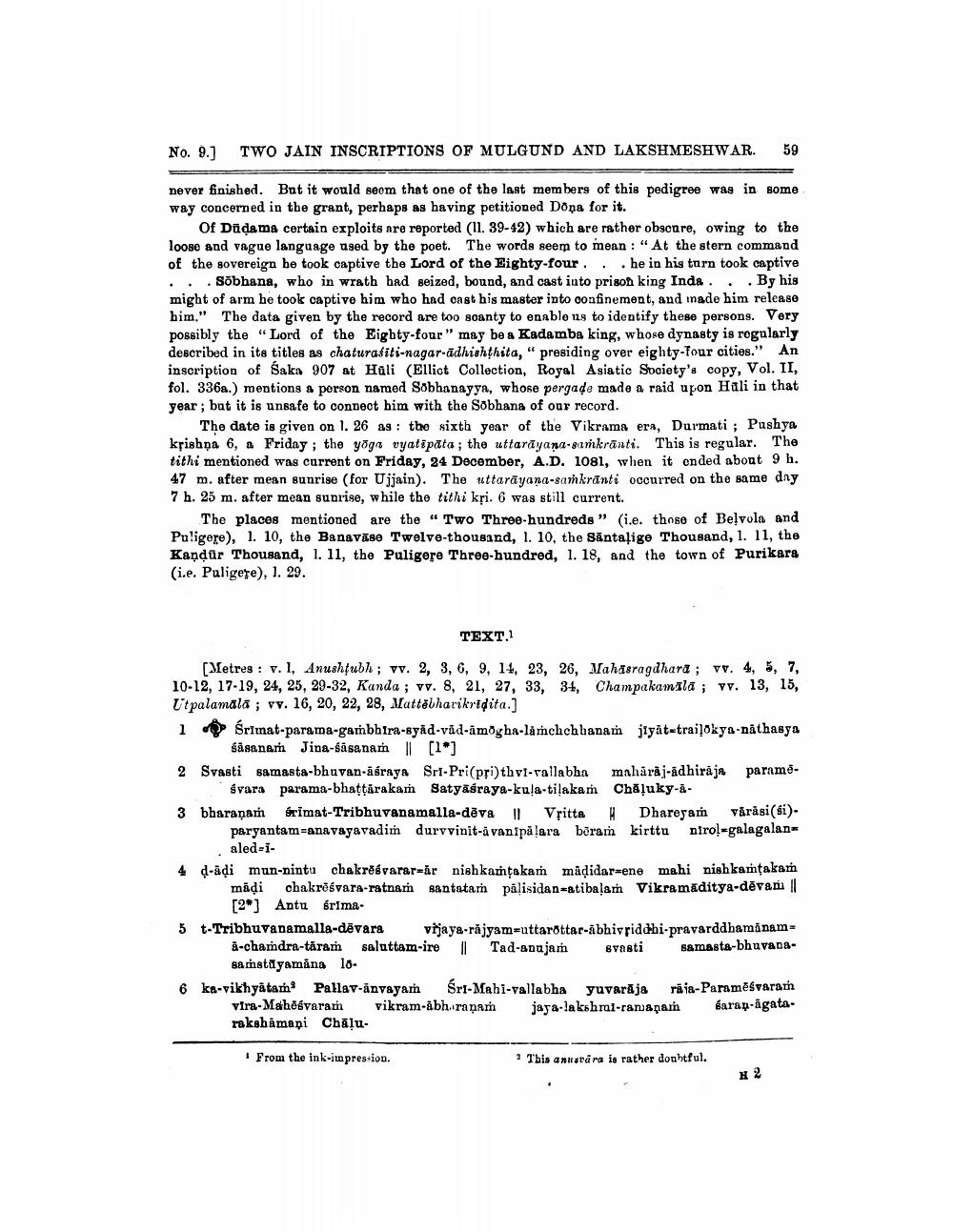________________
No. 9.] TWO JAIN INSCRIPTIONS OF MULGUND AND LAKSHMESHWAR. 59
never finished. But it would seom that one of the last members of this pedigree was in some way concerned in the grant, perhaps as having petitioned Dona for it.
Of Dūdama certain exploits are reported (11. 39-42) which are rather obscure, owing to the loose and vague language used by the poet. The words seem to mean:"At the stern command of the sovereign he took captive the Lord of the Eighty-four..he in his turn took captive ... Sõbhana, who in wrath had seized, bound, and cast iuto prison king Inda . . . By his might of arm he took captive him who had cast his master into confinement, and inade him release him." The data given by the record are too scanty to enable us to identify these persons. Very possibly the "Lord of the Eighty-four" may be a Kadamba king, whose dynasty is regularly described in its titles as chaturasiti-nagar-ādhishthita," presiding over eighty-four cities." An inscription of Saka 907 at Hali (Elliot Collection, Royal Asiatic Society's copy, Vol. II, fol. 336a.) mentions a person named Sobhanayya, whose pergade made a raid upon Huli in that year; but it is unsafe to connect him with the Sobhana of our record.
The date is given on 1. 26 as: the sixth year of the Vikrama era, Durmati ; Pushya ksishņa 6, a Friday; the yoga vyatipata ; the uttarāyana-samkrānti. This is regular. The tithi mentioned was current on Friday, 24 December, A.D. 1081, when it ended about 9 h. 47 m. after mean sunrise (for Ujjain). The uttarāyana-sankranti occurred on the same day 7 h. 25 m. after mean sunrise, while the tithi kļi. 6 was still current.
The places mentioned are the “Two Three-hundreds " (i.e. those of Beļvola and Puligere), 1. 10, the Banaviso Twelve-thousand, 1. 10, the Santalige Thousand, 1. 11, the Kandür Thousand, 1. 11, the Puligere Three-hundred, 1. 18, and the town of Purikara (i.e. Puligere), 1. 29.
TEXT.1
[Metres : v. l, Anushtubh ; vv. 2, 3, 6, 9, 16, 23, 26, Mahasragdhara ; v. 4, 5, 7, 10-12, 17-19, 24, 25, 29-32, Kanda ; vv. 8, 21, 27, 33, 34, Champakamala; vv. 13, 15, Utpalamala ; vv. 16, 20, 22, 28, Mattëbharikridital i Srinat-parama-gambhira-byåd-våd-amogha-lamchchbanan jiyat-trailokya náthasya
sasanam Jina-sasanam || [19] 2 Svasti samasta-bhuvan-asraya Sri-Pri(pri)thvi-Tallabha maharaj-adhiraja parame
Svara parama-bhattārakan Satyasraya-ku!a-tilakam Chăļuky-i3 bharaṇam erimat-Tribhuvanamalla-dēva ! Vritta H Dharegam vårasi(si).
paryantam-anavayavadim durvvinit-ivanipālara boram kirttu nirol-galagalan=
aled-14 d-adi mun-nintu chakreśvarar-år nishkaṁtakam madidar=ene mahi nishkamtakam
mādi chakrösvara-ratnam santatar pálisidan=atibalam Vikramaditya-dēvama l
[2] Antuérima5 t-Tribhuvanamalla-dēvara vijaya-rajyam-uttaröttar-abhivriddhi-pravarddhamanam
ă-chamdra-taram saluttam-ire Tad-anajam svasti samasta-bhuvana
samstayamana 18. 6 ka-vikhyatar Pallav-anyaya Śrl-Mahi-vallabha yuvarāja rāja-Paramēśvaram
vira-Mahēśvara v ikram-abhirana jaya-lakshral-rananam sarap-agatarakshamani Chāļu
1 From the ink-impression.
* This anusvára is rather doubtful.
12




